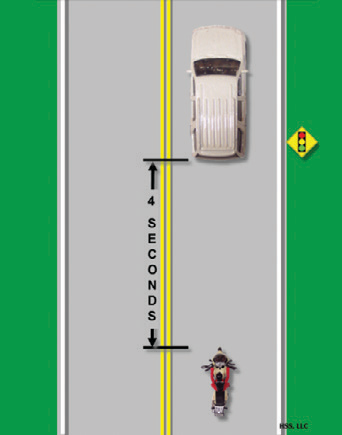
Section 5.4 - 5.5
Following Another Vehicle

Motorcycles need as much distance to stop as cars. It is recommended that new motorcycle operators try to maintain a minimum four-second following distance behind the vehicle ahead. This allows you space to stop, swerve, and keep a reasonable space cushion.
A larger cushion of space is needed if your motorcycle will take longer than normal to stop. For example, if you are riding 40 mph or more, if the pavement is slippery, if you cannot see through the vehicle ahead, or if traffic is heavy and someone may squeeze in front of you, open up a five second or more following distance.
Keep well behind the vehicle ahead even when you are stopped. This will make it easier to get out of the way if someone behind you is not slowing down. It will also give you a cushion of space if the vehicle ahead starts to back up for some reason.
To gauge your following distance:
- Pick out a marker, such as a pavement marking, sign, pole or other stationary point, on or near the road ahead.
- When the rear bumper of the vehicle ahead passes the marker, count off the seconds: “one-thousand-one, one-thousand-two, one-thousand-three, one-thousand-four.”
- If you reach the marker before you reach “four,” you are following too closely.
- Reduce speed and then count again at another stationary point to check the new following interval. Repeat until you are following no closer than “four-seconds.”
Being Followed
Speeding up to lose someone following too closely only ends up with someone tailgating you at a higher speed.
A better way to handle tailgaters is to get them in front of you. When someone is following too closely, change lanes and let them pass. If you can’t do this, slow down and open up extra space ahead of you to allow room for both you and the tailgater to stop. This will also encourage them to pass. If they don’t pass, you will have given yourself and the tailgater more time and space to react in case an emergency does develop ahead.
Lane Sharing
Vehicles and motorcycles need a full lane to operate safely. Do not share lanes with other vehicles. Lane sharing can leave you vulnerable to the unexpected and reduces your space cushion. You should ride in a staggered formation when following other motorcycles. Position the motorcycle in the center of the travel lane, if weather and roadway conditions permit, to discourage motorists from attempting to squeeze by the motorcycle. Do not ride between rows of stopped or moving motor vehicles. This can be dangerous.
Prevent Lane Sharing – Ride in Center of Lane
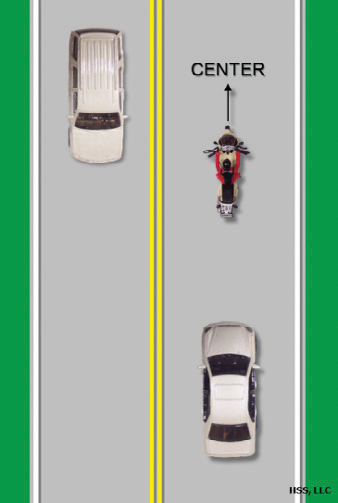
Prevent Lane Sharing – Ride in Staggered Formation
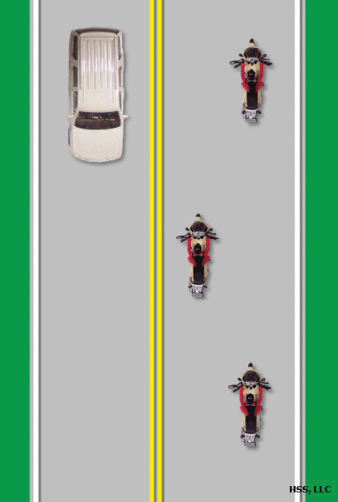
Merging Vehicles
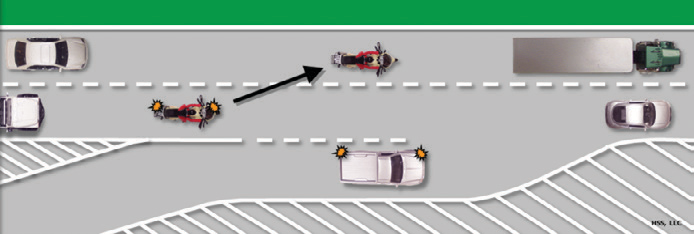
Do not assume that drivers merging on an entrance ramp will see you. Minimize the potential for danger by giving them plenty of room. Change lanes if one is open. If there is no room for a lane change, adjust speed to open up space for the merging driver.
Vehicles Alongside
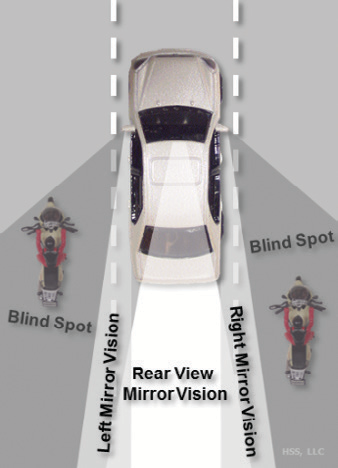
Avoid riding in the blind spot of a vehicle. Responsible riders recognize that vehicles traveling in the adjacent lane may unexpectedly change direction forcing the rider into a potentially dangerous situation. Vehicles in the next lane also block your escape if you come upon a hazard in your own lane. Adjust your speed until a proper and adequate space cushion has been established between vehicles.
5.5 – Escape Routes
An escape route is an alternate path of travel that you can take if a hazard develops in your path. No matter what the conditions, always use SEE and plan an escape route. In the illustration on the top of the next page, the first box shows a rider who has three escape routes open, if an alternate path is needed. The second box shows a rider who has not planned an escape path. The rider has nowhere to go if an alternate path of travel is needed, which leaves the rider vulnerable to potential hazards.
Maintain an Escape Route
Three Escape Routes Open

- Three Escape Routes open:
- Bumper-to-bumper traffic
- Cushion preserved
- Three escape routes open
All Escape Routes Closed
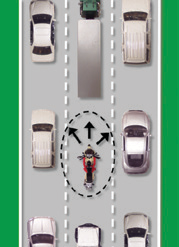
- Truck ahead stops
- Vehicle behind still approaching
- All escape routes closed